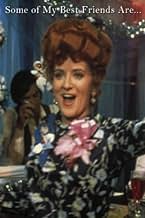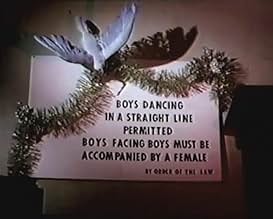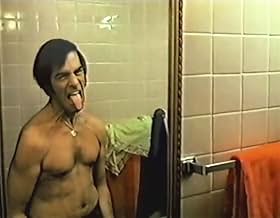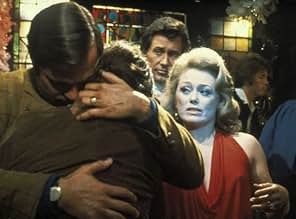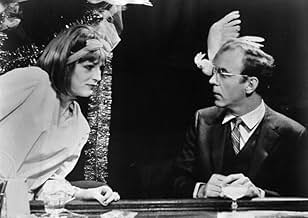A dramatic expose of the lives of a group of gays who meet in a New York City bar on Christmas Eve.A dramatic expose of the lives of a group of gays who meet in a New York City bar on Christmas Eve.A dramatic expose of the lives of a group of gays who meet in a New York City bar on Christmas Eve.
James Murdock
- Clint
- (as David Baker)
Robert Christian
- Eric
- (as Rob Christian)
Nick De Noia
- Phil Drew
- (as Nick DeNoia)
Thomas Fiorello
- Ernie
- (as Tommy Fiorello)
- Director
- Writers
- All cast & crew
- Production, box office & more at IMDbPro
Featured reviews
This is an important piece of cinema. Why? Because it exposes the overall gay experience in its different facets - in this film it is represented through the characters at a bar. They spectrum of characters is like the rainbow flag even if it may not be identifiable or labeled as it is nowadays it does not mean it did not exist, it just means it was all under a few banners of the rainbow at the time. The situations are real, the pain in overwhelming and what makes this masterpiece so poignant is that this may not all be happening at one bar during one night but the film is set up as such.
These are the events lgbt people experienced on a daily basis everywhere from unrequited love only answered in the dark to family troubles to straight identified men having their side lovers. It's all there as it it today all converged beautifully and cinematically in one bar for us all to remember and never forget how times have changed and how far we've come as a society.
A brilliant piece of cinema and case study of how life was for lgbt+ back in 1971. A fine and highly recommended film.
These are the events lgbt people experienced on a daily basis everywhere from unrequited love only answered in the dark to family troubles to straight identified men having their side lovers. It's all there as it it today all converged beautifully and cinematically in one bar for us all to remember and never forget how times have changed and how far we've come as a society.
A brilliant piece of cinema and case study of how life was for lgbt+ back in 1971. A fine and highly recommended film.
It's Christmas Eve at a gay bar in Greenwich Village.
It's a portrait of a bunch of isolated people who, in one of the ending statements, have nowhere else to go. The range of characters run from flashy queens all the way to uptight New Englanders who don't do anything about their sexuality but talk about it. The bar is owned by a woman who presides like a mother at a party; her staff is mostly middle-aged men who go home to their wives. There's an undercurrent of sadness under the almost hysterical holiday partying. Like many of the cheap movies of the era -- of any era, really -- the cast includes actors years after their cinematic prime, like Carleton Carpenter, the current stars of queer cinema, like Candy Darling, and performers before they became well known, like Fannie Flagg, Gil Gerard, and Rue McClanahan.
In the end, Christmas Eve is no time to be alone, and these people are more alone than most.
It's a portrait of a bunch of isolated people who, in one of the ending statements, have nowhere else to go. The range of characters run from flashy queens all the way to uptight New Englanders who don't do anything about their sexuality but talk about it. The bar is owned by a woman who presides like a mother at a party; her staff is mostly middle-aged men who go home to their wives. There's an undercurrent of sadness under the almost hysterical holiday partying. Like many of the cheap movies of the era -- of any era, really -- the cast includes actors years after their cinematic prime, like Carleton Carpenter, the current stars of queer cinema, like Candy Darling, and performers before they became well known, like Fannie Flagg, Gil Gerard, and Rue McClanahan.
In the end, Christmas Eve is no time to be alone, and these people are more alone than most.
Yes, 1970s gay life was no picnic but it was not as bad as presented in this dark movie. But I suppose it could be this way in some situations. Too bad it was not more balanced through use of some positive characters. I was surprised to see some long-time as well as up-and-coming entertainers in this movie: Carlton, Rue and Gil. And the filming technique resembled the handheld shooting technique of more recent horror movies.
I typed the script for SOME OF MY BEST FRIENDS ARE right after grad school at UCLA for Mervyn Nelson. Moved to NY on 8/15/69 (missed WOODSTOCK at the airport) and eventually found a life in NY. When Mervyn made the film I had already been friends with Candy Darling through an incredibly interesting workshop Mervyn ran. Also in the class were Sylvia Sims, Thao Panglis (soap star) and Eric (Hank) Estrada.
I was in a fantasy scene in the film, and found the whole shooting process a great deal of fun, especially with people like Fanny Flagg and Rue McClanahan around. It opened, disappeared and was never heard of again, unless Marty Richards knows who owns it now. I think as a piece of history in gay films, this should not be forgotten. The NY Times got it right in their initial review. Sad, sad, sad.....but it laid the ground for WILL AND GRACE and BROTHERS. SO WHERE CAN I GET A COPY OF IT?
I was in a fantasy scene in the film, and found the whole shooting process a great deal of fun, especially with people like Fanny Flagg and Rue McClanahan around. It opened, disappeared and was never heard of again, unless Marty Richards knows who owns it now. I think as a piece of history in gay films, this should not be forgotten. The NY Times got it right in their initial review. Sad, sad, sad.....but it laid the ground for WILL AND GRACE and BROTHERS. SO WHERE CAN I GET A COPY OF IT?
This story takes place on Christmas Eve in 1971 in an old-fashioned gay bar (there doesn't seem to be a "back room") in Greenwich Village.
We get a bunch of vignettes as the major players tell their stories amid the increasingly uproarious night. No gay cliche is left untold. What defeats much of the film is a murky lighting and lines that are drowned out by noise.
This is not to say that the film is a total dud. It's an important look at that pre-AIDS world and in many ways is a more honest look at gay and closeted-gay life than better known films like THE BOYS IN THE BAND or TORCH SONG TRILOGY or THE RITZ.
There are also several very good performances. In his NY Times review, Vincent Canby noted that the women come off better than the men and he's right. Rue McClanahan is good as the aging "fag hag" who cavorts with gay men as a glamorous token female in a gay world. She dresses like a drag queen and drops acid lines with the best of them. But it's also a sex-free world and therefore a safe world for her.
Sylvia Syms, not to be confused with the British actress of the same name, is excellent as the bar owner Sadie. She's sort of the over-arching mother of all the "boys" and she loves them all. At one point she poignantly tells that she never married, never had children, but she never missed out because she's always had her "boys." On the other hand, Peg Murray plays the hysterical Mrs. Nabour, who pitches a fit when she discovers her son is gay. She disowns him.
Gary Sandy plays a gay hustler who constantly boasts (it seems to be a lie) that he swings both ways, but after a bad drug trip, his self-loathing turns into a blind rage as he beats a timid cross-dresser. The cross-dresser is played by Candy Darling.
Fannie Flagg plays the cheerful hat-check girl with her hair stacked high (a la drag queen) and she even sings a number. David Drew plays a timid man who finally work up the courage to ask someone back to his apartment. Gil Gerard plays a gay man who poses as a straight guy in real life.
James Murdock (billed as David Baker) plays a drama queen who has tricked a guy (Dick O'Neill) into meeting him at the bar by posing as a woman on the phone. Then there's Carleton Carpenter as a silent older man who simply watches all the action without ever getting involved. Paul Blake plays the sarcastic Kenny.
Here and there a character utters a memorable line. One says "Facing death does not take courage. Two men facing a life together does." Another says "Everybody wants someone. Some want anybody."
As a sign of the time, there's a cop prowling around and there's a sign warning the men about dancing together. Although the film takes place after Stonewall, it's still a dangerous time.
If the film had had a central plot and central characters, this might have worked better as a film, As it is, however, it's worth a look into the dark recesses of this very dark bar.
We get a bunch of vignettes as the major players tell their stories amid the increasingly uproarious night. No gay cliche is left untold. What defeats much of the film is a murky lighting and lines that are drowned out by noise.
This is not to say that the film is a total dud. It's an important look at that pre-AIDS world and in many ways is a more honest look at gay and closeted-gay life than better known films like THE BOYS IN THE BAND or TORCH SONG TRILOGY or THE RITZ.
There are also several very good performances. In his NY Times review, Vincent Canby noted that the women come off better than the men and he's right. Rue McClanahan is good as the aging "fag hag" who cavorts with gay men as a glamorous token female in a gay world. She dresses like a drag queen and drops acid lines with the best of them. But it's also a sex-free world and therefore a safe world for her.
Sylvia Syms, not to be confused with the British actress of the same name, is excellent as the bar owner Sadie. She's sort of the over-arching mother of all the "boys" and she loves them all. At one point she poignantly tells that she never married, never had children, but she never missed out because she's always had her "boys." On the other hand, Peg Murray plays the hysterical Mrs. Nabour, who pitches a fit when she discovers her son is gay. She disowns him.
Gary Sandy plays a gay hustler who constantly boasts (it seems to be a lie) that he swings both ways, but after a bad drug trip, his self-loathing turns into a blind rage as he beats a timid cross-dresser. The cross-dresser is played by Candy Darling.
Fannie Flagg plays the cheerful hat-check girl with her hair stacked high (a la drag queen) and she even sings a number. David Drew plays a timid man who finally work up the courage to ask someone back to his apartment. Gil Gerard plays a gay man who poses as a straight guy in real life.
James Murdock (billed as David Baker) plays a drama queen who has tricked a guy (Dick O'Neill) into meeting him at the bar by posing as a woman on the phone. Then there's Carleton Carpenter as a silent older man who simply watches all the action without ever getting involved. Paul Blake plays the sarcastic Kenny.
Here and there a character utters a memorable line. One says "Facing death does not take courage. Two men facing a life together does." Another says "Everybody wants someone. Some want anybody."
As a sign of the time, there's a cop prowling around and there's a sign warning the men about dancing together. Although the film takes place after Stonewall, it's still a dangerous time.
If the film had had a central plot and central characters, this might have worked better as a film, As it is, however, it's worth a look into the dark recesses of this very dark bar.
Did you know
- TriviaThis film was way ahead of its time. One of the characters referred to J. Edgar Hoover as "....a drag queen." In 1971, Hoover was still Director of the Federal Bureau of Investigation (FBI) and viewed as a traditional American hero by the majority of his fellow Americans.
- GoofsWhen the hustler (Gary Sandy) rips off the drag queen's (Candy Darling) wig, her hair ribbon somehow stays attached to her real hair underneath.
- Quotes
Barrett Hartman: Forgive me for not getting up. It's a bit awkward.
Lita Joyce: Don't apologize. I abhor men in a vertical position.
- ConnectionsFeatured in Homo Promo (1991)
- How long is Some of My Best Friends Are...?Powered by Alexa
Details
- Release date
- Country of origin
- Languages
- Also known as
- The Bar
- Filming locations
- Zodiac Bar - 835 Washington Street, Manhattan, New York City, New York, USA(used for Blue Jay bar)
- Production companies
- See more company credits at IMDbPro
Box office
- Gross US & Canada
- $117,169
Contribute to this page
Suggest an edit or add missing content

